Daniel Salzler No. 1225
EnviroInsight.org Four Items October 27, 2023
—————Feel Free To Pass This Along To Others——————
If your watershed is doing something you would like others to know about, or you know
of something others can benefit from, let me know and I will place it in this Information .
If you want to be removed from the distribution list, please let me know.
Please note that all meetings listed are open.
Enhance your viewing by downloading the pdf file to view photos, etc.
The attached is all about improving life in the watershed.
If you want to be removed from the distribution list,
please let me know. Please note that all meetings listed are open.
Check our website at EnviroInsight.org
1. Water Catchments Across Arizona Provide Drinking Water For Wildlife
Kiersten Edgett /Cronkite News

CAREFREE – At the center of all life is water. But, for wildlife in the hot deserts of Arizona, finding it isn’t so easy. That’s where water catchments come in.
Water catchments are systems that collect rainwater and use it to fill a drinking hole for desert-dwelling animals – from honeybees to bighorn sheep.
According to the Arizona Game and Fish Department, there are roughly 3,000 catchments across Arizona.
A catchment looks like a large tin roof on the ground, with one side at a slight incline, known as an apron. Along the lowest side of the apron is a gutter, which feeds any water caught into large tanks below the tin apron. Water stored in the underground tanks then feeds into and automatically refills a small drinking hole nearby, which looks like a cement hole with a side ramp for smaller animals to take a drink.
The program started in the 1940s, and the catchments are managed by three different agencies – Arizona Game and Fish, the U.S. Forest Service and the Bureau of Land Management.
Although some of the water catchment systems are self-sustaining, others require refills using large water trucks, hauling up to 1,700 gallons of water.

Joseph Currie, habitat planning program manager with Arizona Game and Fish, explains the importance of water catchments in Anthem on Sept. 26, 2023. (Photo by Sam Volante/Cronkite News)
Joseph Currie, habitat planning program manager with Arizona Game and Fish, said 2023 was different from past years.
“This summer was not as bad for us, for hauling water, and the only reason was because we had that really wet and cool winter and spring,” Currie said, noting many of the catchments filled up naturally. “We didn’t haul nearly as much as like a couple years ago, where we had a really bad winter and a really bad summer.”
Currie said Arizona Game and Fish hauled an estimated 1 million gallons of water this year. During drier years, the agency has hauled up to 2.6 million gallons. Currie said wildlife used water catchments heavily throughout July and August, when Arizona saw record-breaking temperatures.
“Our summers are super hot and dry, and populations will fluctuate and die off drastically if we’re not able to give them a stable source of water, because water is the most important thing in life,” Currie said.
Nate Solmon, habitat construction field crew supervisor with Arizona Game and Fish, said where the water comes from varies and can include places such as fire departments close to the catchment sites.
“The hardest part is figuring out the logistics and then also where we’re going to get the water from,” Solmon said, noting locations can range from further north Arizona to close to the border.

Solmon’s team that fills the catchments runs on an eight-day-long shift, keeping their gear in the truck and camping near places where catchments may need to be filled. Arizona Game and Fish uses an electronic frequency system to measure the water levels of the catchments, which sends alerts to Game and Fish officials when the levels get too low.
Water for wildlife: Game & Fish refurbishing, replacing old catchment systems
Some days, Solmon’s team drives the water truck up to the site, empties the water tank onto the catchment apron and then waits for the next call. However, for places too difficult to reach using just the water truck, it could require the help of a helicopter.
“We’ll truck water out, we have to find a staging area – we have to try to get as close to the catchment as we can because obviously helicopters are really expensive,” Solmon said of the process with helicopter support. The helicopter then picks up a large tank of water and dumps it onto the apron.
Depending on the temperature, local wildlife and catchment system, Solmon’s team could be taking trips to a specific catchment every four to six weeks.
Arizona Game and Fish currently builds one or two new catchments each year but is primarily focusing on making existing catchments self-sustaining.
2. Why Is Space So Dark Even Though The Universe Is Filled With Stars? Published: October 16, 2023 8.30am EDT

People have been asking why space is dark despite being filled with stars for so long that this question has a special name – Olbers’ paradox.
Astronomers estimate that there are about 200 billion trillion stars in the observable universe. And many of those stars are as bright or even brighter than our sun. So, why isn’t space filled with dazzling light?
You might guess it’s because a lot of the stars in the universe are very far away from Earth. Of course, it is true that the farther away a star is, the less bright it looks – a star 10 times farther away looks 100 times dimmer. But it turns out this isn’t the whole answer.
Imagine a bubble
Pretend, for a moment, that the universe is so old that the light from even the farthest stars has had time to reach Earth. In this imaginary scenario, all of the stars in the universe are not moving at all.
Picture a large bubble with Earth at the center. If the bubble were about 10 light years across, it would contain about a dozen stars. Of course, at several light years away, many of those stars would look pretty dim from Earth.
If you keep enlarging the bubble to 1,000 light years across, then to 1 million light years, and then 1 billion light years, the farthest stars in the bubble will look even more faint. But there would also be more and more stars inside the bigger and bigger bubble, all of them contributing light. Even though the farthest stars look dimmer and dimmer, there would be a lot more of them, and the whole night sky should look very bright.
It seems I’m back where I started, but I’m actually a little closer to the answer.

Age matters
In the imaginary bubble illustration, I asked you to imagine that the stars are not moving and that the universe is very old. But the universe is only about 13 billion years old.
Even though that’s an amazingly long time in human terms, it’s short in astronomical terms. It’s short enough that the light from stars more distant than about 13 billion light years hasn’t actually reached Earth yet. And so the actual bubble around Earth that contains all the stars we can see only extends out to about 13 billion light years from Earth.
There just are not enough stars in the bubble to fill every line of sight. Of course, if you look in some directions in the sky, you can see stars. If you look at other bits of the sky, you can’t see any stars. And that’s because, in those dark spots, the stars that could block your line of sight are so far away their light hasn’t reached Earth yet. As time passes, light from these more and more distant stars will have time to reach us.
The Doppler shift
You might ask whether the night sky will eventually light up completely. But that brings me back to the other thing I told you to imagine: that all of the stars are not moving. The universe is actually expanding, with the most distant galaxies moving away from Earth at nearly the speed of light.
Because the galaxies are moving away so fast, the light from their stars is pushed into colors the human eye can’t see. This effect is called the Doppler shift. So, even if it had enough time to reach you, you still couldn’t see the light from the most distant stars with your eyes. And the night sky would not be completely lit up.
If you wait even longer, eventually the stars will all burn out – stars like the sun last only about 10 billion years. Astronomers hypothesize that in the distant future – a thousand trillion years from now – the universe will go dark, inhabited by only stellar remnants like white dwarfs and black holes.
Even though our night sky isn’t completely filled with stars, we live in a very special time in the universe’s life, when we’re lucky enough to enjoy a rich and complex night sky, filled with light and dark. Source: “The Conversation” Oct. 16, 2023
3. Water – Plant It Wisely: Our Ultimate Fall Planting Resource Put your gardening gloves and shovel to work and get your landscaping on par with the rest of Mother Nature. Water – Plant It Wisely is your handy resource to provide landscaping guidance, advice, and ideas on what to plant. Because what you plant affects more than your yard. It helps create a more sustainable future, and by selecting low-water-use plants, you help conserve our precious water supply for generations to come. Bet you didn’t know your little ol’ garden could do all that. Learn more at our special microsite that puts everything in one easy place – WaterPlantItWisely.com.
Why Plant in the Fall?
Glad you asked! It’s the prime time to plant trees, shrubs, and spring wildflowers in southern Arizona. From late September through early December, soil temperatures are still warm, encouraging root growth and development. Planting now allows plants to become established before next summer’s heat sets in. Also, with cooler temperatures, plants need less water and it is a much more forgiving time of year to put new plants in the ground. If you forget to water just one day in the summer, your new plants can be toast. From the fall season through spring, water newly planted plants once every 3-4 days and gradually increase the number of days between watering as plants get established. Wondering how to plant? How deep to dig the hole? How to use mulch? Be sure to visit our Water – Plant It Wisely site for plant selection tips and proper planting instructions.
Always Plan Before You Plant

After planting your desert plants, top with organic mulch before applying granite or rock.
Planning is essential if you want an attractive, easy-to-maintain, and functional home landscape. Make sure to look at mature plant size and characteristics to determine if their fit and function will work well in your yard.
Water – Use It Wisely Arizona partners have put together great information on saving water outdoors that includes interactive watering guides, landscaping ideas, low-water-use plants, and more. Also, be sure to explore the event calendar on the Water – Use It Wisely home page and find out about the fall landscape workshops we have going on this season!
When you purchase plants for your home landscape, be sure to look for healthy, well-grown plants. Don’t forget to add 2-3 inches of compost or mulch to the surface of the soil after planting and before covering it with granite or rock (keep the mulch a few inches away from the stem or tree trunk). Check with your local plant nursery for the best results. Don’t forget to look for local fall plant sales put on by botanical gardens or others. We’ve included a listing of dates and locations on the microsite.
What are the Benefits of Low-Water-Use Plants?
This fall, replace your high-water-use plants with water-thrifty ones! Desert flora doesn’t require much water to thrive and adds a variety of colors, sizes, and functions that will spruce up your garden. You will love how your yard looks, how much easier it is to maintain, and how your water bills look. With each low-water-use plant you place in your landscape, you can save up to 550 gallons a year. Considering up to 70% of water use is outdoors, you can brag to your neighbors that your beautiful landscape is not only conserving water but is easy to take care of, too.

Benefits of Low-Water-Use Landscapes
- Use up to 60-75% less water than grass or traditional landscapes
- Save water, a precious resource in the desert
- Provide many functions (shade, attracting birds, add color)
- Easier to maintain requiring less fertilizer, pesticides, and care
Don’t Forget to Plant Seeds
Consider Forgoing the Winter Grass
Are you thinking of overseeding your bermudagrass? While sustaining a lush, green lawn throughout the year is appealing to many home and business owners, the additional water needed for cool-season grasses is difficult to justify when water is such a precious resource. Now more than ever, saving every drop we can is critical as we experience extraordinary drought conditions as well as climate pressures that have triggered water shortages to our Colorado River water supplies.
Need more help to decide whether or not to forgo the winter lawn? First, see the Top Ten Reasons Not to Overseed with Winter Rye. If you decide you still want to overseed, keep it as efficient as you can with the timing, watering, and limiting the areas.

Mexican poppy, lupine seeds, and other wildflowers should be planted in the fall for spring bloom.
Plant Wildflowers
Are you looking for carpets of golden poppies or spikes of violet lupines? Even though they bloom in the spring, fall is the time to sow many of the wildflower seeds in your landscape. If possible try to sow shortly before one of our October or November rains. For good details on wildflower gardening, request our free booklet, “Landscape Plants for the Arizona Desert,” or read our blog, “Plant of the Month: Wildflowers!” for more information.
Avoid wildflower or ‘meadow’ mixes from other parts of the country or world. For example, African Daisies are… well, from Africa. Look for quality, locally grown, or collected seed that includes beauties such as Mexican Gold Poppies, Arizona Lupines and Desert Bluebells. The Native Seed Company out of Tucson provides high-quality, locally collected native seeds. Seeds are not available for online ordering but can be found at most local nurseries or specialty plant sales. However, you can also order them through Native Seeds/SEARCH online.Source: Water Use It Wisely
4. Halloween: Keep It Safe For Yourself And For The Children. When Is Halloween 2023?
Halloween is celebrated each year on October 31. Halloween 2023 will take place on Tuesday, October 31.
Ancient Origins of Halloween
Halloween’s origins date back to the ancient Celtic festival of Samhain (pronounced sow-in). The Celts, who lived 2,000 years ago, mostly in the area that is now Ireland, the United Kingdom and northern France, celebrated their new year on November 1.
This day marked the end of summer and the harvest and the beginning of the dark, cold winter, a time of year that was often associated with human death. Celts believed that on the night before the new year, the boundary between the worlds of the living and the dead became blurred. On the night of October 31 they celebrated Samhain, when it was believed that the ghosts of the dead returned to earth.
|
In addition to causing trouble and damaging crops, Celts thought that the presence of the otherworldly spirits made it easier for the Druids, or Celtic priests, to make predictions about the future. For a people entirely dependent on the volatile natural world, these prophecies were an important source of comfort during the long, dark winter.
To commemorate the event, Druids built huge sacred bonfires, where the people gathered to burn crops and animals as sacrifices to the Celtic deities. During the celebration, the Celts wore costumes, typically consisting of animal heads and skins, and attempted to tell each other’s fortunes.
When the celebration was over, they re-lit their hearth fires, which they had extinguished earlier that evening, from the sacred bonfire to help protect them during the coming winter.

On May 13, A.D. 609, Pope Boniface IV dedicated the Pantheon in Rome in honor of all Christian martyrs, and the Catholic feast of All Martyrs Day was established in the Western church. Pope Gregory III later expanded the festival to include all saints as well as all martyrs, and moved the observance from May 13 to November 1.
By the 9th century, the influence of Christianity had spread into Celtic lands, where it gradually blended with and supplanted older Celtic rites. In A.D. 1000, the church made November 2 All Souls’ Day, a day to honor the dead. It’s widely believed today that the church was attempting to replace the Celtic festival of the dead with a related, church-sanctioned holiday.
All Souls’ Day was celebrated similarly to Samhain, with big bonfires, parades and dressing up in costumes as saints, angels and devils. The All Saints’ Day celebration was also called All-hallows or All-hallowmas (from Middle English Alholowmesse meaning All Saints’ Day) and the night before it, the traditional night of Samhain in the Celtic religion, began to be called All-Hallows Eve and, eventually, Halloween. Source: https://www.history.com/topics/halloween/history-of-halloween
Copyright 2023 EnviroInsight.org
